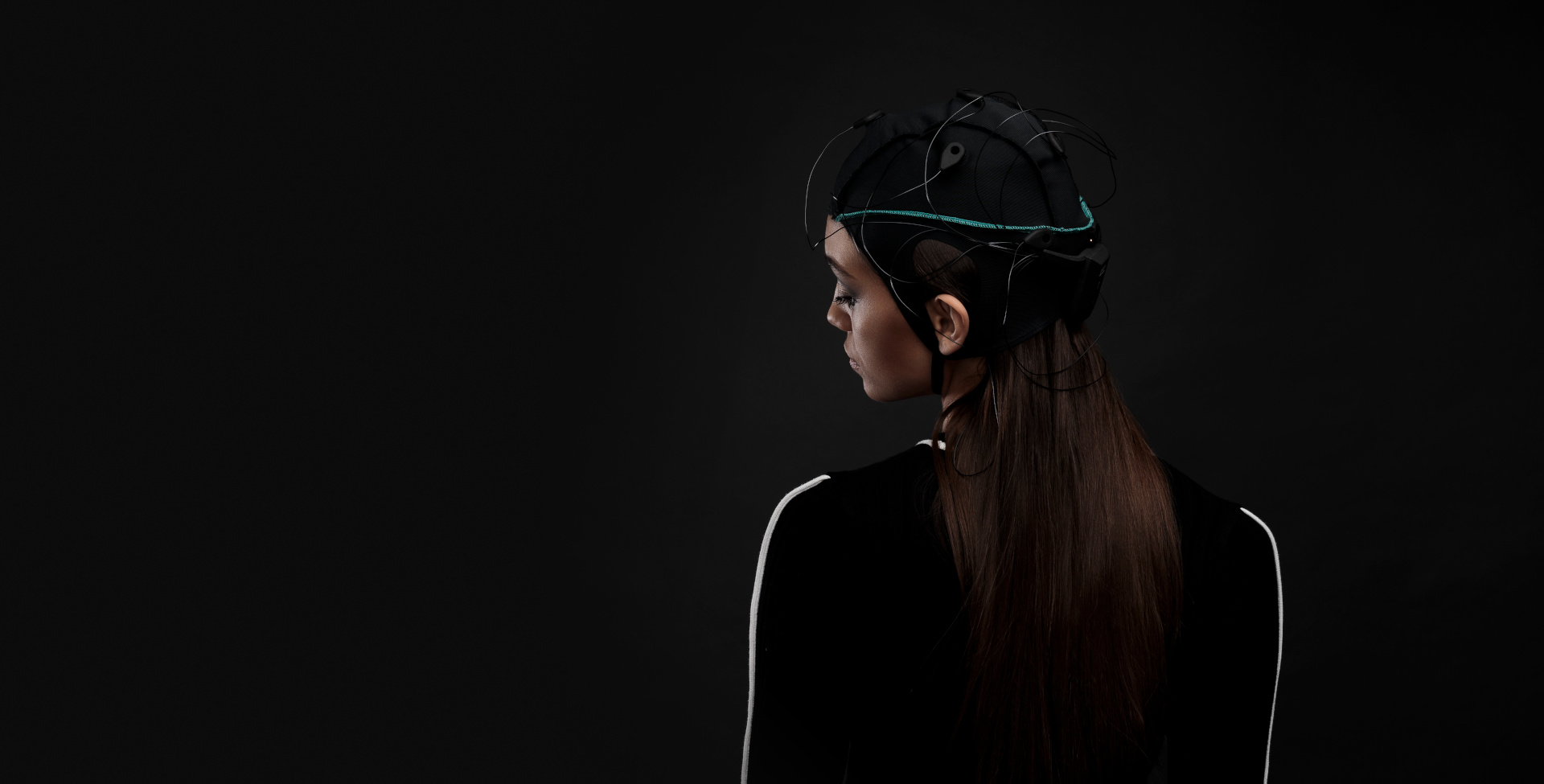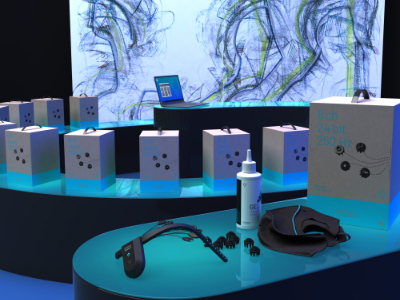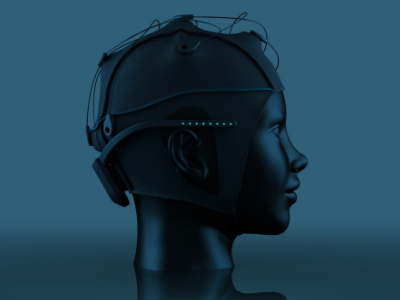
*BR41N.IO and Spring School 2024 offer more than 140 hours of online courses and lectures. Perfectly designed to integrate it in your curriculum. Read more about g.tec's Unicorn Education Kit.
BR41N.IO is a brainstorming and collaborative marathon designed to be a learning experience for developers, technologists, engineers, students, artists, and scientists who cram and build brain-computer interface (BCI) applications together in teams.
Who can participate?
Anyone can participate who has interests in BMI, BCI, robotics, AR, VR, machine learning, computing, sensors, human-machine interface systems, control, signal processing, big data, haptics, rehabilitation, and similar areas. Even better: it is for FREE.
Participants do not have to be a BMI expert to participate on a team! Interdisciplinary teams with a combination of BMI and non-BMI skills are often successful in building solutions and producing working prototypes.
I am a Unicorn Hybrid Black owner. How can I participate?
Do you have a Unicorn Hybrid Black at home or at your University/Institution? Great! Let's put together a team of students and participate with your own Unicorn Hybrid Black at the virtual BR41N.IO Hackathon. Our gaming or programming projects are most suitable for you.
Can I submit a different project?
Professional teams can also participate to develop applications during the BR41N.IO Designers' Hackathon to demonstrate full potential of some of the sponsored hardware/software.
If you are looking for additional skills from other team members, your project will be included among the BR41N.IO projects below for application. Submit your project to contact@br41n.io.
What's in there for me?
Be creative, think outside the box. The BR41N.IO Designers' Hackathon is fun and gets you to network and collaborate with other Geeks. The best BR41N.IO projects will be awarded with cash prizes:
GAMING PROJECT PRIZES:
- 1st BR41N.IO Prize: $ 1000
- 2nd BR41N.IO Prize: $ 600
- 3rd BR41N.IO Prize: $ 400
PROGRAMMING & ARTISTIC PROJECT PRIZES:
- 1st BR41N.IO Prize: $ 1000
- 2nd BR41N.IO Prize: $ 600
- 3rd BR41N.IO Prize: $ 400
DATA ANALYSIS PRIZES:
- 1st BR41N.IO Prize: $ 1000
- 2nd BR41N.IO Prize: $ 600
- 3rd BR41N.IO Prize: $ 400
Join the virtual Spring School!
g.tec's Spring School 2024 is the educational forerunner of the Virtual BR41N.IO Hackathon. Therefore, it's highly beneficial if you join the Spring School from April 22 - May 1, 2024 virtually. Why? Because the Spring School is an online education event, where you acquire all the knowledge you need to be perfectly prepared to compete with your fellows at the BR41N.IO Hackathon competition and create your own BCI applications!
Sign up for a BR41N.IO project!
There are several predefined projects which you can choose to work on. Below, the projects are described in detail including hard- and software requirements.
The Unicorn Hybrid Black and the Unicorn Suite should be used to join a Gaming or a Programming Project. But, you can use your own hardware and software for the BR41N.IO hackathon. In case you don't have a BCI Headset, we recommend to join an Offline Data Analysis Project.
Meet your team virtually!
We will connect you with the team members of your project. Create your own virtual meeting space using Skype, Google Hangouts, Zoom, etc. to start working on your ideas.
Stay connected with us via Discord!
Join g.tec's official Discord Server to connect with your team members! While you work on your groundbreaking new BCI applications, we are here to answer all the questions that might come up and support you wherever we can.
Present your projects virtually and win!
You will be invited to present your results virtually via Zoom. Prepare yourself to explain what you did, what the results are and to show a demonstration (live or with a video) to the international audience and jury.
BCI PRINCIPLES
Brain-computer interfaces are realized by 4 different principles:
slow waves
steady-state visual evoked potentials (SSVEP)
motor imagery (MI)
evoked potentials (EP)
In the BR41N.IO Hackathon Series, motor imagery and EP based systems
are mostly used to control the applications:
In the case of the motor imagery application, participants have to imagine e.g. left or right hand movement to produce an event-related desynchronization over the sensorimotor cortex. This is basically an amplitude change of the alpha and beta regions of the EEG.
In the case of EPs, the BCI system is showing different flashing icons and the user has to attend to the icon he wants to select. When the icon flashes on the computer screen, than a P300 wave is produced in the brain and the BCI system is able to detect it.
FOR UNICORN HYBRID BLACK OWNERS
Do you have a Unicorn Hybrid Black, a Unicorn Naked BCI or the Unicorn Education Kit at your university or at your lab? Great! Let's put together 40 students in teams of 5 students and let them participate and compete against other international students at this virtual BR41N.IO Hackathon.
As Unicorn Education Kit owner, you'll qualify as a Hosting Institution for this BR41N.IO Hackathon. This means, you'll get a speaking slot during the hackathon and raise awareness for your university.
Unicorn Education Kit is perfectly designed for professors who teach brain-computer interfaces, biomedical engineering or signal processing.
It comes with 8 Unicorn Hybrid Black devices including full access to the Unicorn Suite software.


Unicorn Hybrid Black is a wearable 8-channel EEG device that measures high-quality EEG signals from your brain.
It is perfectly suitable for creating your own brain-computer interface or neuroscience applications.
SCHEDULE
Time Zone: Vienna Time
Saturday April 27, 2024
| 9:00 | BR41N.IO BCI Hackathon Introduction – A Hackathon Series by g.tec medical engineering Christoph Guger, g.tec medical engineering GmbH (AT) |
| 9:30 | Unicorn Hybrid Black & Unicorn Headband Demonstration Martin Walchshofer, Leo Schreiner, g.tec medical engineering (AT) |
| 10:30 | Unicorn Unity Gaming Interface Michele Romani, Bernard Wong, g.tec medical engineering (AT) |
| 11:00 | Motor Imagery, P300, SSVEP, ECoG datasets Sebastian Sieghartsleitner, Johannes Grünwald, g.tec medical engineering (AT) |
| 11:30 | Start BR41N.IO Hackathon with Hosting Institutes & Team Formation Christoph Guger (AT), Maryam Alimardani (NL), Luis Emilio Bruni (DK), Niels Erik Raursø (DK), Abdelkader N. Belkacem (UAE), Arianna Di Bernardo (IT), Enrico Sansone (IT), Lijiljana Trajkovic (CA), Cosmin Bonchis (RO), Camil Mihaescu (RO), Javier Mauricio Antelis Ortiz (MX), Leonardo Ferrisi (USA), Nakhon Pathom (TH), Ferat Sahin (USA), Zhida Li (USA), David Grayden (AU), Angelica Peer (IT), Susan Boehnke (CA), Saman Sargolzaei (USA), Luca Turchet (IT), David Wiehls (CN) |
| 12:00 |
All day hacking |
| 16:00 |
Neurotechnology and the Community: learnings from the decade and the path forward |
| 24:00 | All night hacking |
Sunday April 28, 2024
| 6:00 | All night & day hacking |
| 14:00 | Project Presentations of Each Team |
| 18.00 |
BR41N.IO Ceremony |
| 18:30 | BR41N.IO Participation Certificates |
HOSTING INSTITUTIONS
Universities who are proud owners of the Unicorn Education Kit automatically qualify as hosting institution. Official hosting institutions are fully embedded in the BR41N.IO Designers' Hackathons. Boost your institution’s visibility and awareness and benefit from a big audience.
Hosting institutions provide on-site access to EEG devices and brain-computer interface technology that you would need for programming projects. Just let us know at which hosting institition you would like to participate during the BR41N.IO Hackathon.
G.TEC
AUSTRIA
g.tec medical engineering GmbH
Dr. Christoph Guger
Schiedlberg, Austria
VRIJE UNIVERSITEIT AMSTERDAM
Department of Computer Science
Prof. Maryam Alimardani
Amsterdam, Netherlands
AALBORG UNIVERSITY
MeCIS Media Cognition & Interactive Systems
Prof. Luis Emilio Bruni, Niels Erik Raursø
København , Denmark
TILBURG UNIVERSITY
Cognitive Science and AI Enigma Study Association
Tilburg, Netherlands
UAE UNIVERSITY
ABU DHABI
United Arab Emirates University
Prof. Abdelkader N. Belkacem
Abu Dhabi, United Arab Emirates
WEST UNIVERSITY TIMISOARA
Mathematics Faculty & Fine art and Design
Prof. Cosmin Bonchis & Prof. Camil Mihaescu
Timisoara, Romania
TEC DE MONTERREY
Campus Guadalajara
Javier Mauricio Antelis Ortiz, PhD.
Jalisco, Mexico
NEW YORK INSTITUTE OF TECHNOLOGY
Vancouver Campus, Department of Computer Science, Dr. Zhida Li
Vancouver, Canada
FREE UNIVERSITY OF BOZEN-BOLZANO
Free University of Bozen-Bolzano
Prof. Angelika Peer
Bozen, Italy
CHONGWEN CULTURE AND EDUCATION
Hangzhou Chongwen Century City Experimental School, David Wiehls
Hangzhou, China
UNIVERSITY OF TENNESSEE MARTIN
Brain Autonomy and Resiliency (BAR) Lab, Prof. Saman Sargolzaei
Martin, Tennessee, USA
UNIVERSITY OF TRENTO
Creative, Intelligent & Multisensory Interactions (CIMIL) Lab, Prof. Luca Turchet
Povo Trento, Italy
UNIVERSIDAD DEL VALLE
PSI Research Group, Prof. Humberto Loaiza Correa, Wilfredo Alfonso & David Reyes
Cali, Colombia
LULEÅ TEKNISKA UNIVERSITET
Brain Analysis Research Project, Prof. Foteini Liwicki & Rajkumar Saini, PhD.
Lulea, Sweden
PSNC FUTURE LABS
Poznan Supercomuting & Networking Center, Adam Olszewski PhD. Ewelina Moszyk and Szymon Kupinski Poznan, Poland
QUEEN’S UNIVERSITY
NeuroTech Discovery Lab, Centre for Neuroscience Studies, Dr. Susan Boehnke, PhD
Ontario, Canada
UNIVERSITY OF MELBOURNE
Department of Biomedical Engineering
Prof. David Grayden
Melbourne, Australia
JURY
BCI GAMING PROJECTS*
*These projects require a Unicorn Hybrid Black or a BCI system.
Shooting Games
Create a shooting game that can be controlled with a brain-computer interface and shoot the targets with your EEG signals.
soft-/hardware: Unicorn Hybrid Black, Unicorn Unity Interface, Unity
participants: 2 groups, 5-8 people per group
skills: Basic programming skills (C#/Unity)
Racing Games
You like speeding with your car but it's not safe in reality? Then you can create a racing game in which you can speed as much as you want with your EEG signals.
soft-/hardware: Unicorn Hybrid Black, Unicorn Unity Interface, Unity
participants: 2 groups, 5-8 people per group
Skills: Basic programming skills (C#/Unity)
Adventure Games
Start the adventure and begin the journey to treasure hunting. You can choose the elements in the game with your EEG signals.
soft-/hardware specifications: Unicorn Hybrid Black, Unicorn Unity Interface, Unity
participants: 2 groups, 5-8 people per group
skills: Basic programming skills (C#/Unity)
Your Gaming Project
You are invited to create your own gaming project for this hackathon. You have a Unicorn Hybrid Black or any other kind of BCI to create your game.
soft-/hardware specifications: Unicorn Hybrid Black, Unicorn Unity Interface, Unity
participants: 2 groups, 5-8 people per group
skills: Basic programming skills (C#/Unity)
Sports Games
Whether you want to play Tennis or Bowling or any sports game virtually, you can use your EEG signals to hit the shot.
soft-/hardware: Unicorn Hybrid Black, Unicorn Unity Interface, Unity
participants: 2 groups, 5-8 people per group
skills: Basic programming skills (C#/Unity)
Card Games
You like playing cards? Then crank it up a notch and play cards using brain computer interfaces. You can choose the items in your game with your EEG signals.
soft-/hardware specifications: Unicorn Hybrid Black, Unicorn Unity Interface, Unity
participants: 2 groups, 5-8 people per group
skills: Basic programming skills (C#/Unity)
Educational Games
You can create an educational game in which you can choose the options with your EEG signals.
soft-/hardware specifications: Unicorn Hybrid Black, Unicorn Unity Interface, Unity
participants: 2 groups, 5-8 people per group
skills: Basic programming skills (C#/Unity)
Play Games
Take the Platformer Game, Brain Buddies Game, Puzzle Game, Blondy Check or another BCI Game and play by using your brainwaves only.
soft-/hardware specifications: Unicorn Hybrid Black, Unicorn Naked BCI, Unicorn Unity Interface
participants: 2 groups, 5-8 people per group
skills: Gaming skills
Strategy Games
The decision making in strategy games can be performed with EEG signals. The strategy games range from chess to war games.
soft-/hardware: Unicorn Hybrid Black, Unicorn Unity Interface, Unity
participants: 2 groups, 5-8 people per group
skills: Basic programming skills (C#/Unity)
Puzzle Games
Puzzle games are fun but why bothering using your fingers. Move the items in your game with your EEG signals.
soft-/hardware: Unicorn Hybrid Black, Unicorn Unity Interface, Unity
participants: 2 groups, 5-8 people per group
skills: Basic programming skills (C#/Unity)
Rehabilitation Games
Create a Unity based game that can be used for rehabilitation purposes.
soft-/hardware: Unicorn Hybrid Black, Unicorn Unity Interface, Unity
participants: 2 groups, 5-8 people per group
Skills: Basic programming skills (C#/Unity)
BCI PROGRAMMING PROJECTS*
*These projects require a Unicorn Hybrid Black or a BCI system.
Orthosis Control
It is possible to control a 3D printed orthosis using a Unicorn Hybrid Black with motor imagery. It is possible to move an orthosis by thinking about left or right hand motion. Watch the Orthosis Control video.
soft-/hardware: Unicorn Hybrid Black, Unicorn Speller, bring your own orthosis or use Unity instead
participants: 2 groups, 5-8 people per group
Skills: Basic programming skills (Matlab, Simulink), basic graphics programming skills with Unity
Your Hacking Project
You are invited to create your own programming project for this hackathon. You'll have all the BCI headsets or you bring your own BCI to design and program your own fully functional headset.
soft-/hardware specifications: Unicorn Hybrid Black, tbd
participants: 2 groups, 5-8 people per group
skills: Basic programming skills
Towards Unicorn Hybrid Black Integration with ACAT
Intel’s ACAT is a free open-source platform originally developed for Prof. Stephen Hawking. Develop a standalone ERP-based application using .NET, C# and SharpDX. This will be integrated by Intel engineers in ACAT and put into open source. Visit our website for more detail, Assistive Context-Aware Toolkit (intel.com).
soft-/hardware specifications: ACAT Toolkit, Unicorn Hybrid Black
participants: 1 group, 5-8 people
skills: Basic programming skills (C#, .Net, SharpDX)
Dream Painting
If you want to create a Dream Painting, you have to wear a Unicorn Brain Interface while you sleep. When you wake up, you are able to create a picture based on EEG signals.
soft-/hardware: Unicorn Hybrid Black, Unicorn Painting
participants: 2 groups, 5-8 people per group
skills: Basic programming skills (Matlab, Simulink)
Smartphone
Control the apps on your smartphone with a brain-computer interface.
soft-/hardware: Unicorn Hybrid Black, Unicorn Suite
participants: 1 group, 5-8 people per group
skills: Basic programming skills
Connect Your Brain to Chat GPT
Become a superhuman that knows the answers to all the questions by connecting Unicorn Hybrid Black to Chat GPT.
soft-/hardware specifications: Unicorn Hybrid Black, Unicorn Suite
participants: 2 group, 3-5 people per group
skills: Basic programming skills
fNIRS and EEG Control
The team can use fNIRS (functional near-infrared spectroscopy) and EEG simultaneously to control BCI applications.
soft-/hardware: g.Nautilus fNIRS
participants: 1 group, 5-8 people per group
skills: Basic programming skills (Matlab, Simulink)
Intel Assistive Context Aware Toolkit (ACAT)
Intel’s ACAT is a free open-source platform originally developed for Prof. Stephen Hawking. It enables people with disabilities to communicate. The latest release includes BCI capabilities. Developers are encouraged to expand its capabilities. Visit our website for more detail, Assistive Context-Aware Toolkit (intel.com)
soft-/hardware specifications: ACAT Toolkit, Unicorn Hybrid Black
participants: 1 group, 3-5 people
skills: Basic programming skills (C#, .Net)
BCI DATA ANALYSIS PROJECTS*
*no hardware required.
Stroke Rehab Data Analysis
Analyze a motor imagery BCI data-set from a chronic stroke patient in order to optimize pre-processing, feature extraction and classification algorithms. Compare your results with state-of-the-art algorithms.
soft-/hardware: MATLAB or other signal processing platform that is able to read in the MATLAB matrix
participants: 3 groups, 3-5 people per group
skills: signal processing skills
P300 Speller Data Analysis
Analyze a visual P300 BCI data-set from a healthy person in order to optimize pre-processing, feature extraction and classification algorithms. Compare your results with state-of-the-art algorithms.
soft-/hardware: MATLAB or other signal processing platform that is able to read in the MATLAB matrix
participants: 3-5 people per group
skills: signal processing skills
ECoG Video Watching Analysis
Analyze an ECoG data-set from an epilepsy person watching a video. The ECoG was recorded from regions on the temporal base that is coding colors, black/white, shapes, faces and much more. Try to optimize pre-processing, feature extraction and classification algorithms. Compare your results with state-of-the-art algorithms.
soft-/hardware: MATLAB or other signal processing platform that is able to read in the MATLAB matrix
participants: 3-5 people per group
skills: signal processing skills
Unresponsive Wakefullness Syndrom Data Analysis
Analyze a vibro-tactile P300 BCI data-set from a patient with disorders of consciousness in order to optimize pre-processing, feature extraction and classification algorithms. Compare your results with state-of-the-art algorithms.
soft-/hardware: MATLAB or other signal processing platform that is able to read in the MATLAB matrix
participants: 3 groups, 3-5 people per group
skills: signal processing skills
SSVEP Data Analysis
Analyze an SSVEP BCI data-set from a healthy person in order to optimize pre-processing, feature extraction and classification algorithms. Compare your results with state-of-the-art algorithms.
soft-/hardware: MATLAB or other signal processing platform that is able to read in the MATLAB matrix
participants: 3-5 people per group
skills: signal processing skills
Locked-in Patient Data Analysis
Analyze a vibro-tactile P300 BCI data-set from a patient with locked-in syndrom in order to optimize pre-processing, feature extraction and classification algorithms. Compare your results with state-of-the-art algorithms.
soft-/hardware: MATLAB or other signal processing platform that is able to read in the MATLAB matrix
participants: 3 groups, 3-5 people per group
skills: signal processing skills
ECoG Hand Pose Data Analysis
Analyze an ECoG BCI data-set from an epilepsy person in order to optimize pre-processing, feature extraction and classification algorithms. Compare your results with state-of-the-art algorithms.
soft-/hardware: MATLAB or other signal processing platform that is able to read in the MATLAB matrix
participants: 3-5 people per group
skills: signal processing skills
BCI ARTS PROJECTS
Unicorn Painting
Create images according to your brain activity that you measure with the Unicorn Brain Interface.
soft-/hardware: Unicorn Hybrid Black, Unicorn Speller (includes Painting add-on)
participants: 3-5 people per group
Visual Arts & BCI
Finding new ways of developing artistic projects using Unicorn BCI.
soft-/hardware: Unicorn Hybrid Black
participants: 3-5 people per group
Design Unicorn Naked BCI in 3D
Expand the Unicorn Brain Interface with your own 3D printed parts. Let them move, light, hold things or simply look nice. Watch the video 3D Headset Design.
soft-/hardware: Unicorn Naked BCI, 3D software
participants: 2 groups, 3-5 people per group
Skills: Basic CAD
Design Unicorn Brain Interface with Sewing Machines
Give the Unicorn Brain Interface a new, fashionable look.
soft-/hardware: Unicorn Naked BCI, sewing machines, fabrics and craftiing material
participants: 2 groups, 3-5 people per group







